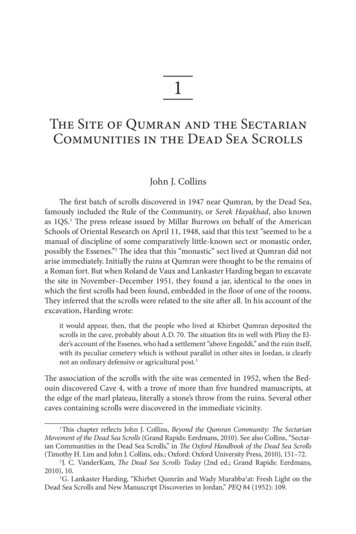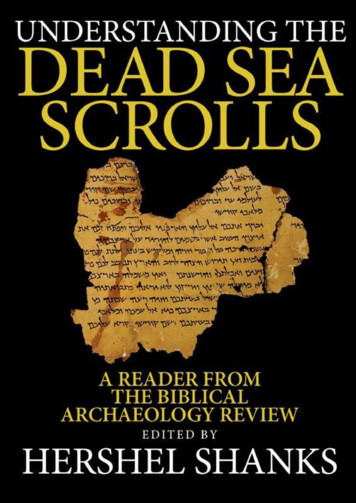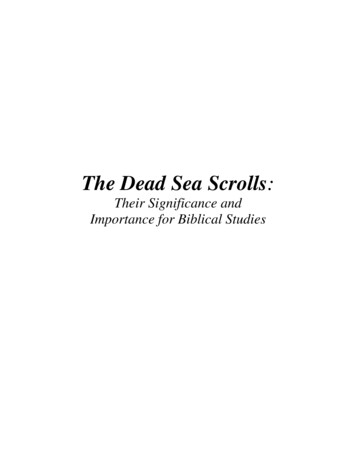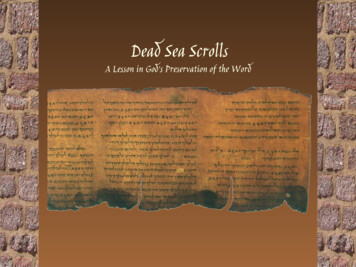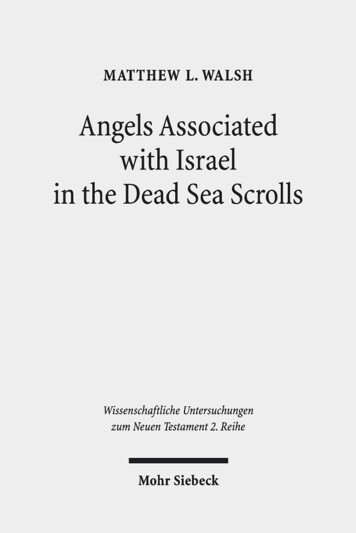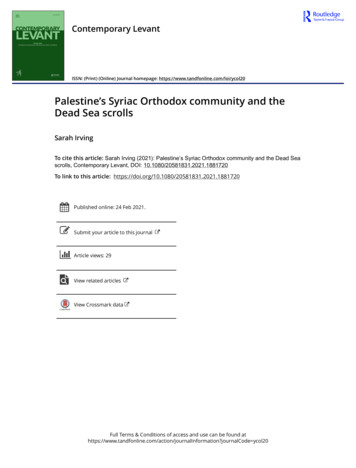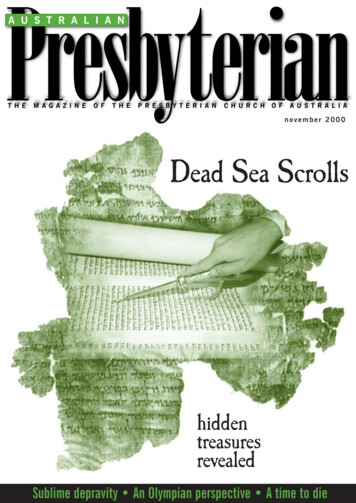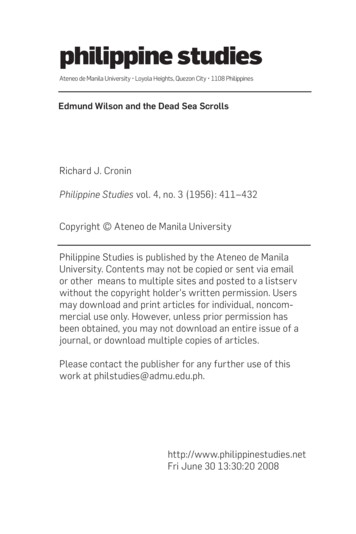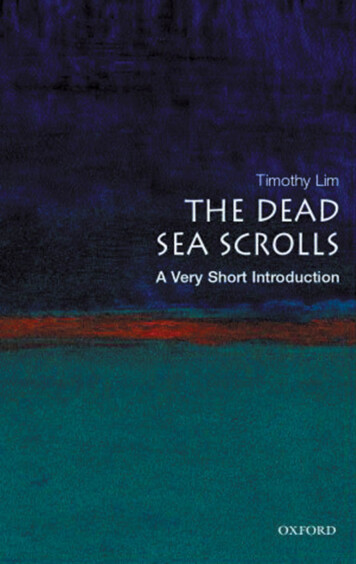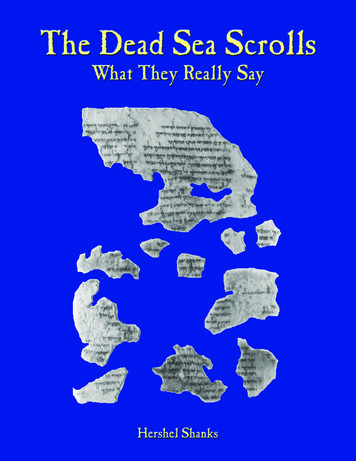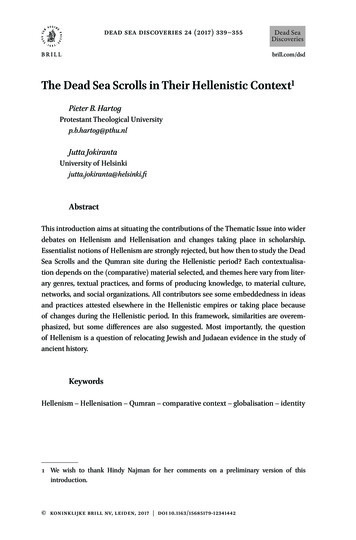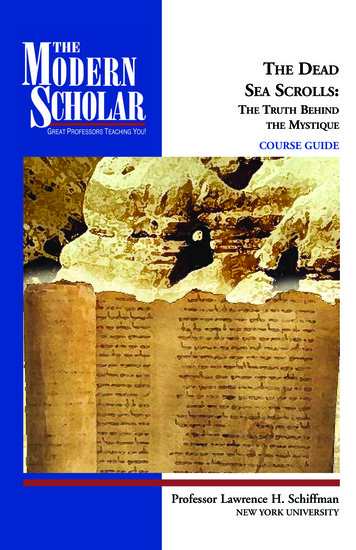
Transcription
THE DEADSEA SCROLLS:THE TRUTH BEHINDTHE MYSTIQUECOURSE GUIDEProfessor Lawrence H. SchiffmanNEW YORK UNIVERSITY
The Dead Sea Scrolls:The Truth Behind the MystiqueProfessor Lawrence H. SchiffmanNew York UniversityRecorded Books is a trademark ofRecorded Books, LLC. All rights reserved.
The Dead Sea Scrolls:The Truth Behind the Mystique Executive ProducerJohn J. AlexanderExecutive EditorDonna F. CarnahanRECORDINGProducer - David MarkowitzDirector - Matthew CavnarCOURSE GUIDEEditor - James GallagherKaren SparroughDesign - Edward WhiteLecture content 2007 by Lawrence H. SchiffmanCourse guide 2007 by Recorded Books, LLCCover image: Joseph Calev/shutterstock.com72007 by Recorded Books, LLC#UT102 ISBN: 978-1-4281-5625-8All beliefs and opinions expressed in this audio/video program and accompanying course guideare those of the author and not of Recorded Books, LLC, or its employees.
Course SyllabusThe Dead Sea Scrolls:The Truth Behind the MystiqueAbout Your Professor.4Introduction.5Lecture 1The Library of Qumran .6Lecture 2Scandal and Publication .12Lecture 3Sects of the Second Temple Period.17Lecture 4The Halakhic Letter and the Founding of the Sect.22Lecture 5The Qumran Sect .27Lecture 6Women and the Dead Sea Scrolls Sect .32Lecture 7Theology and Beliefs of the Dead Sea Sect .37Lecture 8Biblical Interpretation .42Lecture 9The Hebrew Bible in Second Temple Times .46Lecture 10The Messiah and the End of Days .51Lecture 11The Temple Scroll .56Lecture 12The Scrolls, Judaism, and Christianity .62Lecture 13Controversial Messianic Texts.67Lecture 14The Scrolls in Public Culture .72Course Materials .773
Photo courtesy of Lawrence H. SchiffmanAbout Your ProfessorLawrence H. SchiffmanLawrence H. Schiffman is chairman of New York University’s SkirballDepartment of Hebrew and Judaic Studies and serves as Ethel and Irvin A.Edelman Professor of Hebrew and Judaic Studies. He is also a member ofthe University’s Centers for Ancient Studies and Near Eastern Studies. He isa past president of the Association for Jewish Studies. He currently serves aseditor-in-chief of the Center for Online Judaic Studies in New York.Professor Schiffman was featured in the PBS Nova television series documentary, “Secrets of the Dead Sea Scrolls,” as well as in four BBC documentaries on the scrolls, the McNeil-Lehrer program, and a Discovery special. Heappears regularly in the popular educational series “Mysteries of the Bible,”which appears on Arts and Entertainment (A&E), and he appeared in Kingdomof David on PBS.Professor Schiffman received his B.A., M.A., and Ph.D. degrees from theDepartment of Near Eastern and Judaic Studies at Brandeis University. He is aspecialist in the Dead Sea Scrolls, Judaism in late antiquity, the history ofJewish law, and Talmudic literature. His publications include The Halakhah atQumran (E.J. Brill, 1975); Sectarian Law in the Dead Sea Scrolls: Courts,Testimony, and the Penal Code (Scholars Press, 1983); Who Was a Jew?Rabbinic Perspectives on the Jewish-Christian Schism (Ktav, 1985); From Textto Tradition: A History of Second Temple and Rabbinic Judaism (Ktav, 1991); aHebrew book entitled Halakhah, Halikhah u-Meshihiyut be-Khat MidbarYehudah (Law, Custom, and Messianism in the Dead Sea Sect) (MerkazShazar, 1993); the jointly authored monograph, Hebrew and Aramaic MagicalTexts from the Cairo Genizah (Sheffield, 1992); Reclaiming the Dead SeaScrolls (Jewish Publication Society, 1994; Doubleday paperback, in the AnchorResearch Library, 1995); and almost two hundred articles on the Dead SeaScrolls and Rabbinic Judaism. His most recent book is Texts and Traditions:A Source Reader for the Study of Second Temple and Rabbinic Judaism(Ktav, 1998).4
Joseph Calev/shutterstock.comIntroductionThis series of lectures sets before the public the real Dead Sea Scrolls, ourmost important collection of Jewish texts from the centuries before the rise ofChristianity. Only through efforts to understand what the scrolls can teach usabout the history of Judaism is it possible for us to learn what they have toteach us about the history of Christianity, because Christianity came intobeing only after these texts were composed and copied. Despite many falseclaims to the contrary, the scrolls do not mention John the Baptist or Jesus,because they are Jewish texts composed before the rise of Christianity.Rather, they illuminate the Judaism of the period after the composition of theHebrew Scriptures and before the solidification of postbiblical Judaism andthe rise of Christianity.Although this description of the scrolls collection may seem obvious, its fullimplications for the understanding of both Judaism and Christianity haveonly recently been recognized. The popular press remains far behind thescholars who, despite disagreements on many specific matters of interpretation, have reached virtual consensus on this central point. In fact, the mediacontinue to provide a forum for exaggerated and irresponsible claims thatthe scrolls belong primarily to the Christian domain or that they represent thenormative Judaism of the Jerusalem Temple, both patently incorrect.Numerous books have come out advocating theories of the scrolls that areincompatible with the texts and the archaeological evidence. To a greatextent, we can attribute such unfounded series to the unfortunate veil ofsecrecy that long surrounded the scrolls. But the monopoly of the originalpublication team has been completely lifted for some time, and responsibleand intelligent syntheses such as that proposed here are becoming thenorm. It is my hope that these recordings will enable listeners to draw theirown conclusions about the Dead Sea Scrolls, perhaps the most importantarchaeological discovery of the twentieth century.5
Lecture 1:The Library of QumranThe Suggested Reading for this lecture is Lawrence H. Schiffman’sReclaiming the Dead Sea Scrolls: Their True Meaning for Judaism andChristianity, introduction and chapters 1 through 3.A Discovery of Immeasurable ImportThe Dead Sea Scrolls are arguably the most important find of the twentiethcentury. These scrolls illuminate the history of Western civilization and religious tradition in a way that is immeasurable, and they provide valuableinsights into the background of Christianity and the development of Judaism.The average discussion of the Dead Sea Scrolls begins with what hasbecome a kind of foundation myth: A young Bedouin goatherd wanderingnear a place called Qumran threw a stone into a cave while looking for one ofhis goats and discovered a group of scrolls in jars. The more important questions, however, are not how the scrolls were discovered, but what they areand what they are not, as well as the question of why they should be studied.What Are the Dead Sea Scrolls?First of all, most of the Dead Sea Scrolls are not really scrolls. In reality,there are about ten scrolls that can actually be rolled out on a table and read.Many of the Dead Sea Scrolls are the fragments of what were once scrolls inancient times, but that over the years have deteriorated because of the waythey lay in their cases. Today, approximately 5 to 10 percent of the originalcollection remains.The Dead Sea Scrolls were an ancient library, what once upon a time was acollection of entire scrolls numbering somewhere close to nine hundred.Today, they are a small collection of complete scrolls and a large number ofremnants, something like eighty thousand pieces that, when fit together,account for approximately twenty thousand pieces. These twenty thousandpieces occupy about twelve thousand of what are called plates. These usedto be behind glass and are today kept in special rice paper. These are theremnants of approximately nine hundred scrolls, and because many of theseare duplicates, they are the remnants of a library of some 250 texts fromancient times.The Dating of the ScrollsLECTURE ONEThe scrolls can be dated by a number of means, including carbon-14 datingand paleography, the study of the shape of letters and the way in which writing developed. Then there is historical dating, which entails looking at thecontents of the material and its language.It appears that the scrolls were copied, a few in the third century BCE, alarge number in the second and first centuries BCE, and a few in the firstcentury CE. In terms of the actual composition of the scrolls, the earliest6
scrolls are copies of the Hebrew Bible, and Hebrew Bible compositions canbe dated from around 1200 BCE and on; the latest composition in the collection would be in the first century BCE. This means that the scrolls were allcomposed before the rise of Christianity.The scrolls were found at a location called Qumran, which is a modernArabic designation for a place a bit south of Jericho, along the Dead Sea,where some ruins of buildings were found that apparently were used by thesectarians who gathered the scrolls. These scrolls were then placed incaves in this area, and apparently the gathering process occurred during theperiod in which the buildings were occupied.The settlement existed sometime after 134 BCE or, by another reckoning,sometime after about 100 BCE. It was destroyed in 68 CE during the GreatRevolt of the Jews against Rome, which took place between 66 and 73 CEand which resulted in events that are well known today: the destruction of theJewish Temple in Jerusalem in 70 CE and the destruction of the last stronghold of the rebels, Masada, in 73 CE.Some of the books in the ancient sectarian library of Qumran were a partof their religious heritage and other books were composed by them. Manyof the scrolls were not composed at the sectarian settlement of Qumran,and many of them are not, in fact, compositions of the group who occupiedthese buildings.What the Scrolls Are NotThe scrolls are not Christian and there is absolutely no distinctively Christianidea found in the Dead Sea Scrolls, nor in the scrolls is there even the possibility that any of them were authored after the rise of Christianity. Here andthere in the scrolls are important ideas that help to explain where certainChristian ideas come from, ideas that were not previously known within theorbit of Judaism. Increasingly, whether it is in the land of Israel or theHellenistic world, more and more Christian ideas can be traced to Jewishroots. This is one of the great contributions of modern scholarship, but it oftenleads people to jump to the conclusion that some of those materials that helpexplain the origins of Christianity are somehow Christian, and they are not.The scrolls are also not documents of third- and fourth-century Christians, ashas been put forward.There was a theory that these were documents from a medieval Jewishsect known as the Karaites, literalists who had not accepted the Talmudicinterpretations of the rabbis, people who thought the Bible should be takenliterally. Carbon-14 dating, however, proves they could not be responsiblefor the scrolls.More recently, it was put forth that Qumran was not a sectarian center butwas, in fact, a fortress. Therefore, all the manuscripts were brought fromJerusalem and represent Judaism at that time. The problem here is that thistheory does not seem to take into account either the archaeology or the content of the scrolls. Archaeologically, the Qumran site just isn’t a fortress, evenif it has a watchtower and some security perimeter. The documents from theQumran collection constantly argue against the Jerusalem Temple’s procedures, as if these procedures were impure and not kosher. If these were the7
documents of those who led the Jerusalem Temple, then one would expect tofind some documents that supported the status quo.Another assumption has been that the Qumran area was a kind of bookproduction facility simply because a lot of books were there. There is evidence that there may have been a scriptorium, a place for the copying ofmanuscripts, but it is known that many of the manuscripts were broughtthere from elsewhere, so there is no real support for the notion that Qumranwas a book factory.Among other assumptions was that Qumran had to be a trade emporiumbecause a small boat dock was found between the site and the Dead Sea.There is a massive cemetery between the so-called Qumran settlement andthe Dead Sea, and beyond that is an area where the sea would have beenin antiquity before it receded. There is evidence there of a boat dock, but theexistence of a boat dock does little on its own to support the idea of Qumranas a trade emporium.There really is little question that the so-called Qumran settlement was a religious community dedicated to the collecting and studying of a library ofbooks, and it was a group dedicated to a life of purity and piety.Studying the ScrollsIn the study of the scrolls, there has been an overcentralization of the actualgroup who lived at Qumran and who gathered the scrolls. Much of what hasbeen studied is the nature of this group, the way of life of the group, and thearchaeology of the site. But the real significance of the scrolls goes waybeyond that. What should really be studied is the nature of the Judaism of thesecond and first centuries BCE, because what is really, really interesting isthe subsequent development of both Judaism and Christianity, which formthe story to a greater extent of the foundations of Western civilization.An overconcentration on the sectarian group itself and on theChristianization of the scrolls has, curiously enough, reduced the chances ofbetter understanding Christianity through the scrolls. The scrolls can tell anenormous amount about the background of many ideas and historicalprocesses in early Christianity, but in order to understand these, one mustdistance oneself and attempt to understand what the scrolls say about theJudaism that is at the background of Christianity. Looking at the group asthough they were proto-Christians has made it impossible for many scholarsto use the scrolls properly to understand the background of Christianity.When one looks at the period between the end of the storyline of theHebrew Bible, about 450 BCE, and the period in the second and third centuries, when Judaism is becoming Talmudic Judaism and Christianity isbecoming a separate religion, the scrolls represent an enormous contributionto the understanding of the history of ideas and the history of religion.LECTURE ONEThe scrolls aren’t the only sources for this period either. There is also the historian Josephus, and there are books in the Apocrypha (Jewish books preserved in the Catholic Bible and in the Greek translations of what Christianscall the Old Testament) and books from an informal collection called pseudoepigrapha, the collection of books preserved in various Eastern churches that8
date from the third, second, and first centuries BCE and the first century CE.When these other sources are viewed together with the Dead Sea Scrolls, thehistory of this period is illuminated in a magnificent way.Who Gathered the Scrolls?Most scholars have come to the conclusion that the sect who left the scrollsis the group called the Essenes, a sect described by a variety of Jewishauthors who wrote in Greek in the first century BCE and by Josephus andPliny the Elder, the Roman author. There are a lot of parallels between theEssenes and the Dead Sea group, and the average book on the Dead SeaScrolls will simply say that the Dead Sea group is the Essenes or a subset ofthem. But the matter is more complex.Another group to consider is the Sadducees, who were a priestly group.Parallels can be made between their views on Jewish law and those of theQumran sect. In fact, the Qumran sect may have originated from a group ofpious Sadducees.There are about twenty theories about what the word “Essene” means. Wedon’t really know what these people were called, and the name “Essene”doesn’t appear anywhere in the Dead Sea Scrolls. “Essene” could even be aterm for a collection of sectarian groups that have a lot in common.One cannot simply assume the identity of the Qumran group from thedescriptions of the Essenes among Jewish authors and in Pliny. Even so, theQumran group is strongly parallel in many ways to the sect of the Essenes.At the same time, one should also caution against the assumption that theEssenes can be viewed as proto-Christians. This assumption ignores fundamental differences between the Qumran group and the early Christians. Forinstance, the sectarian scrolls encourage hatred of outsiders and sinners, anapproach that is negated both by Pharasitic Judaism and its ethics and alsonegated by early Christianity, which to a great extent drew its ethics from thePharasitic tradition.The Materials in the LibraryThe scrolls collection can be divided into three parts: first, biblical scrolls,texts previously known from the Hebrew scriptures.Second are texts called apocryphal, which doesn’t refer to the Apocrypha,but rather to books about the Bible, like the Bible, or imitative of the Bible.Both of these types of works are a window into the way Jews in third-, second-, and first-century Judea understood and studied the Bible.These two types of works, Hebrew Bible and apocryphal-type texts, are notunique to the group who occupied the settlement at Qumran and collectedthe scrolls. In fact, these are texts that were spread throughout the Jewishcommunity in Judea and would have been read by Jews in Hebrew and insome cases in Greek. In addition, biblical and apocryphal-type texts werealso found at Masada.The third type of text in the Qumran collection is unique to the collectionand is what are called sectarian texts. These are documents that have thedistinctive ideas and terminology of the Qumran sectarians and were com9
posed by them, and they are the most likely of the collection to have beencopied at Qumran.LECTURE ONEThese three classes of documents make up the library of the Qumran sectarians. It’s important to note that this was a library and the books wereactively used. They got worn down and had to be fixed, sometimes by second and third and even fourth scribes. They show evidence that sometimesthey were rewound properly, and sometimes they weren’t.10
FOR GREATER UNDERSTANDINGQuestions1. What are the main categories of literature in the collection we call theDead Sea Scrolls?2. How do we know that the Dead Sea Scrolls are pre-Christian?Suggested ReadingSchiffman, Lawrence H. Reclaiming the Dead Sea Scrolls: Their TrueMeaning for Judaism and Christianity. Garden City, NY: AnchorDoubleday, 1995.Other Books of InterestVanderKam, James C., and Peter Flint. The Meaning of the Dead SeaScrolls: Their Significance for Understanding the Bible, Judaism, Jesus,and Christianity. Reprint ed. San Francisco: HarperSanFrancisco, 2004.11
Lecture 2:Scandal and PublicationThe Suggested Reading for this lecture is Lawrence H. Schiffman’sReclaiming the Dead Sea Scrolls: Their True Meaning for Judaism andChristianity, chapters 2 and 3.The Famous Bedouin BoyThe first Dead Sea Scroll was not found in 1947 by the famous Bedouin boylooking for his missing goat. It was actually found much earlier.Beginning in the late 1800s, fragments of Hebrew manuscripts from a synagogue in Old Cairo began to become known in Europe. Solomon Schechter,who found out about the scrolls in 1896 and who was a faculty member atCambridge University, decided that he would journey to this synagogue,known as the Ben Ezra Synagogue, and recover the rest of the manuscripts.Among these texts was a document that Schechter recognized as beingfrom the Second Temple period, a book known as Ben Sira, or Sirach, orEcclesiasticus.Schechter acquired the collection, some 250,000 items of incredible importance to the history of Hebrew and Judaic literature. As Schechter delved intothese materials, he found a document that is now generally referred to as theDamascus Document.This text would later be found in ten copies among the fragmentary manuscripts from Qumran. Schechter had thereby succeeded in finding what wasessentially the first Dead Sea Scrollin 1897.Some thought these materials belonged to early Christians. Some thoughtthey were the documents of the Zadokites, referring to a group similar to theSadducees. Others claimed that the fragments Schechter had found wereKaraite manuscripts. Others thought that these were proto-Rabbinic Pharisaicdocuments. In any case, this debate went on from Schechter’s publication in1911 until the Dead Sea Scrolls were found in 1947. The debate, however,was interrupted by World War II and the Holocaust, which all but froze biblicaland Judaic studies.These studies reopened immediately in 1947 when the Bedouin boy enteredthe cave at Qumran looking for a missing animal from his flock and found theseven complete scrolls. The story of the Bedouin boy is a bit more complex,however, than its retelling would imply.LECTURE TWOThe Sale of the SevenThe Bedouin boy’s name was Mohammad Adib (Mohammad the Wolf), andhe was part of a clan of Bedouins known as Ta’amireh, who were heavilyinvolved in the antiquities trade. The boy’s immediate relations would havespent much of their time prospecting for antiquities, so it’s safe to concludethat the boy was actually searching for antiquities when he found the scrolls.12
Unfortunately, the boy was a poor judge of the worth of his find, for itseems that he sold the whole thing for about 125. The sale divided theoriginal seven scrolls into two groups, the first group of four scrolls purchased on behalf of the soon-to-be State of Israel by Eliezer Sukenik, thehead of the Institute of Archaeology at the Hebrew University.An intermediary purchased the other three and sold these to AthanasiusYeshua Samuel, the Syrian Metropolitan (bishop of the Syrian church inJerusalem), and he eventually sold these to Yigael Yadin, the famous archaeologist who was also the son of Sukenik (Yadin had changed his name). In1954, Yadin was able to buy the scrolls because he was in the United Stateson a lecture tour and there was an ad for the scrolls that appeared in the WallStreet Journal. Yadin acquired these scrolls for a quarter of a million dollars.This placed the seven original scrolls in the hands of Israel, and they weredeposited in the Shrine of the Book, where they sit today, in the IsraelMuseum of Jerusalem. However, what then ensued was the search for theplace of origins for these manuscripts, for Qumran.The Scandal of the ScrollsAfter the first group of scrolls was acquired by Sukenik, and before the others were acquired, there ensued the 1948 war of independence of the Stateof Israel. This war left the region split in two. Jordan occupied what wasknown as the West Bank and the east part of Jerusalem, and the rest of theterritory ended up in the hands of the new State of Israel. This meant thatQumran was in the hands of Jordan.The Jordanians immediately set out to find the place from which the scrollshad come and soon located the caves of Qumran. The entire publicationfight, the so-called “Scandal of the Scrolls” reported in the late 1980s andearly 1990s, had nothing to do with the scrolls found by the Bedouin boy.They pertained to those scrolls found in Jordan after Jordan took control ofthe area after the 1948 war.Once the Jordanians had located the place from which the scrolls had come,they began the systematic archaeological excavation of the area of Qumranunder Father Roland de Vaux and G. Lankester Harding. De Vaux was aDominican monk and an important French archaeologist who worked at theÉcole Biblique. Harding was a Englishman who stayed in Jordan to be headof the Antiquities Department after the British mandate was eliminated withIsrael’s War of Independence in 1948.While these scholars began digging at Qumran, the very same Ta’amirehBedouins came to work at the excavations. When the archaeologists wouldgo home for the weekend, Ta’amireh would go into the caves searching formore manuscripts to sell to a fellow nicknamed Kando, who was the verysame antiquities dealer who had been involved in the buying and selling ofthe original seven scrolls.In September 1952, Caves 4 and 6 were found. It was Cave 4 that wouldyield some 550 to six hundred fragmentary manuscripts.Throughout the early 1950s, there was a constant stream of manuscript fragments that the Bedouins sold to Kando, which Kando then sold to the13
Palestine Archaeological Museum in East Jerusalem, which is now theRockefeller Museum.De Vaux and Harding set up a process to sort and publish the material.After trying to have some of de Vaux’s colleagues at the École Biblique dothe job, it became clear that a larger publication team for this material wasneeded.A group of Christian scholars, Catholics and Protestants, was assembled. Atthis time, Jordan was free of Jews, and the idea of having Jews participate inthis process was absolutely impossible. It also seems that some of thoseinvolved in the initial process were anti-Semites who sought to keep Jews outof the process. But to be fair, others were upstanding scholars who keptclose relations throughout with Jewish and Israeli scholars.The notion that this initial group was only Catholic is not true, and it shouldalso be noted that the Vatican had nothing to do with the process. The rumorthat the Vatican kept the scrolls secret is simply unfounded. However, it isalso true that of the Protestants who got involved in the beginning, onebecame agnostic, one converted to Catholicism, and one withdrew from theprocess. So by the end, the project was overwhelmingly Catholic.Those involved sorted the manuscripts according to handwriting, composition, and genre, but what they were not able to do was publish the whole lot.This situation dragged on until the 1967 war between Israel and its Arabneighbors. This war caused a transfer of territory, including Qumran and theRockefeller Museum, to Israeli hands.Toward PublicationAfter 1967, one would have expected that the Israelis would have broughtin their own people to get the material published, but this didn’t happen.A series of false commitments was made by the publication team andthen there was a dragging out of the entire situation. But an important thinghappened during the 1967 war that would bring about a new approach to theDead Sea Scrolls and a completely different recognition of their significance.In 1960, Reverend Joseph Uhrig contacted Yigael Yadin and told him thathe had a then-unknown Dead Sea Scroll. He asked Yadin for a deposit of tenthousand dollars and in return provided a few fragments of the scroll. AfterYadin gave him the money and received the fragments, Uhrig disappeared.LECTURE TWOIn May of 1967, the antiquities dealer Kando somehow managed to have ameeting with Frank Cross of Harvard, an important Dead Sea Scrolls scholar,and tried to sell him this very same scroll, now known as the Temple Scroll,under a bridge in Lebanon. Cross couldn’t buy the scroll because he couldn’tlegally export it from Israel.By the time the 1967 war started in June, Yadin knew that he had to recoverthis scroll. With the help of Israeli intelligence agents, he was able to persuade Kando to give up the scroll, which had been rotting under the floorboards of his home in Bethlehem. On behalf of Israel, Yadin acquired thesixty-six-column long Temple Scroll, a document that set forth a long list ofJewish laws.14
This managed to energize the study of the Dead Sea Scrolls. On the onehand, it emphasized the extent to which the scrolls should be understood asa source for the history of the Judaism of the time. On the other hand, thisscroll showed that there was more to be done, not simply in the caves, but interms of the documents sitting unpublished.Still, it took a while for Yadin to publish the scroll, and after the scroll cameout in a Hebrew edition, the English edition was delayed until 1983. (Yadinwas heavily involved in the process of investigating the perceived failures ofIsrael in the 1973 Yom Kippur War.)Soon after the publication of the Temple Scroll, an important Israeli scholardelivered a presentation on a text that has become very important to DeadSea Scrolls scholars. This text is abbreviated as MMT, Hebrew for “some rulesand regulations for observing the Torah.” This text further showed how significant the still-unpublished scrolls were and also raised issues regarding theidentity of the sect and the role of the Sadducees in its history.Interestingly, the effect of the 1967 Israeli takeover was delayed until the1980s when the combination of the publication of the Temple Scroll and theannouncement of the MMT text made it very clear that Dead Sea Scrollsmaterial had to be published in total. At present, every single scroll hasbeen published.15
FOR GREATER UNDERSTANDINGQuestions1. What factors delayed the publication of the Dead Sea Scrolls for somany years?2. What led to t
Title: UT102 Dead Sea Scrolls Bklt.qxp Created Date: 8/6/2008 12:32:43 PM
